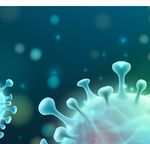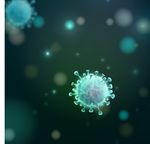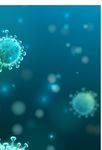NATO SPS MULTI-YEAR PROJECT SARS-COV-2 MULTI-MESSENGER MONITORING FOR OCCUPATIONAL HEALTH & SAFETY (SARS 3M) - SCIENCE FOR PEACE AND SECURITY ...
←
→
Page content transcription
If your browser does not render page correctly, please read the page content below
Science for Peace
and Security (SPS)
Programme
NATO SPS Multi-Year Project
SARS-CoV-2 Multi-Messenger
Monitoring for Occupational
Health & Safety (SARS 3M)
Virtual Launch
Thursday, 27 May 2021
11:15-13:00 (CEST)
Emerging
Security
Challenges
DivisionProject Overview
Context The SARS-CoV-2 pandemic has created many new challenges
to society. One of them is how to guarantee safety and
occupational health, maintaining a high environmental
security.
This project proposes an innovative nanotechnology-based
platform to monitor the SARS-CoV-2 virus and other toxic
bio-agents in the workplace. The project will design new
plasmonic nanoporous materials capable of selecting and
efficiently adsorb the virus, providing its identification and
quantitative evaluation by multi-messenger (infrared and
terahertz) vibrational spectroscopy. The combination of
nanotechnology and high-sensitivity vibrational spectroscopy
will open the way to a cost-effective alternative to existing
monitoring techniques.
Goals • New methodological approach to air-quality monitoring,
reliant on the combination of advanced nanotechnology-
based platforms and high-sensitivity vibrational spec-
troscopy.
• Development of an appropriate nanostructured plasmonic
platform transparent to terahertz (THz)/infrared (IR)
radiation to detect the presence of pathogens.
• Investigation of the potential correlation between SARS-
CoV-2 proteins’ secondary structures and functionality at
various environmental conditions.
• Fabrication of a new biosensor, highly flexible and suitable
to the early detection also of other pathogens.
• Development of a fast and economic tool with high
sensitivity and selectivity to enhance protection from and
prevention of viral infection spread.
• Ensuring a portable and user-friendly solution working in
real-time, and marketable on a large scale.
2 3How does • A nanostructured materials platform is used for active Deliverables 1. Design of the biosensor chip and the acquisition,
it work? air sampling, like a filter. The sensors are exposed to installation and testing of accessories for vibrational THz/
air-flux, monitoring environmental conditions, such as IR spectroscopy.
temperature, humidity, sampling time, flow rate, pressure, 2. First spectroscopic characterization and identification of
etc. SARS-CoV, MERS and SARS-CoV-2 spike proteins S and
• Air goes through the sensors, and the viral pathogens of their subunits at various environmental conditions (such
interest are trapped thanks to the easy functionalization as temperature, humidity, pressure, pH, etc…).
and/or high adsorption ability. 3. Realization of 2D Zeolitic Imidazole Framework-8 (ZIF-
• THz/IR spectral interrogation techniques are applied on 8) structures by ZnO via CVD on commercially available
exposed sensors for a highly efficient reading. Silicon/Germanium substrates and their IR/THz
• Polychromatic THz/IR radiation source illuminates the spectroscopic characterization, to prevent a loss of the
sensors and pathogens, and it absorbs the frequencies signal in the spectral region of interest.
associated to the roto-vibrational modes of pathogens. 4. Evaluation of the geometric aspect ratio and density
parameters for high pathogen concentration. In particular,
3D pillared biosensors will be realized and optimized, and
their performance will be evaluated to gain information
about stability, robustness, limit of detection (LOD), signal-
to-noise ratio (SNR), sampling effects (such as mechanical
stress, sampling time, flow rate, etc).
5. Design of a portable THz/IR spectrometer.
6. The nanostructured chip sensor will be spectroscopically
characterized from THz to IR. The reading efficiency of a
functionalized microchip will be proven through multi-
▼
Working principle of SARS-CoV-2 Multi-Messenger Monitoring
for occupational health & safety device
Project flowchart
4 5messenger investigations, starting from the saturated
concentration of the analyte on the biosensor towards very Programme
low concentrations, in order to reproduce the conditions
of a working environment.
Validation of the proposed methodological approach with
11:15 – 11:45 Opening Session
intercomparison of the results achieved using different
methodological approaches for airborne particulate Moderator: Dr. Eyup Turmus, SPS Advisor and Programme
sampling reproducing working environment conditions. A Manager, NATO
portable spectrometer coupled to 3D nanostructured ZIF-8 • Mr. David Van Weel, Assistant Secretary General for
sensors will be used in working environments. Emerging Security Challenges, NATO
Workshops, scientific conferences, scientific publications, • H.E. Mr. Francesco Maria Talò, Permanent
and reports on progress. Representative of Italy to NATO
• H.E. Mrs. Elisabeth Kornfeind, Ambassador of Austria to
NATO and to the Kingdom of Belgium
• Dr. Deniz Beten, Senior SPS and Partnership Cooperation
Advisor, NATO
Impact
• Prof. Paolo Mataloni, Director of the Department of
Physics, Sapienza University of Rome, Italy
• Prof. Georg Gescheidt-Demner, Director of the Institute
of Physical and Theoretical Chemistry, Graz University of
Technology, Austria
11:50 – 13:00 Presentation of ‘SARS 3M’ project
The project’s co-directors will present the project, its
objectives, scope and deliverables, including the roles and
responsibilities, timelines, communication and meeting
plans, and discuss the next steps.
Speakers:
• Prof. Stefano Lupi, NATO Project Director (NPD),
Sapienza University
• Prof. Paolo Falcaro, NATO Partner Country Director
(PPD), Graz University of Technology
Introduction of young researchers
Questions and Answers session
13:00 Meeting Closure
6 7Participating Institutions
Sapienza University of Rome (Department of Physics),
Italy
Founded in 1303, Sapienza is the oldest university in Rome
and the largest in Europe. The Department of Physics, is the
natural heir of the tradition of Enrico Fermi, Ettore Majorana
and Edoardo Amaldi (School of Rome), and is renowned
throughout the world for high quality research, in high-
energy particles and condensed matter.
Graz University of Technology (TU Graz), Austria
Graz University of Technology (TU Graz) was founded by
Archduke Johann in 1811. It is one of the five universities in
Styria (Austria) and currently comprises seven Faculties, with
more than 13 000 students. TU Graz combines its research
into five Fields of Expertise in which researchers work in
an interdisciplinary way, both with the regional economy
and internationally. This unique ecosystem creates ideal
conditions for scientific excellence and technology transfer.
8 9The Science for Peace and Security (SPS) Programme
The Science for Peace and Security (SPS) Programme is an
established brand for NATO based on four pillars: science, Every year, approximatively 2000 experts participate
partnership, security, and unconventional issues (hybrid in SPS activities and help to build capacity in partner
threats). It has been contributing to the core goals of the nations, and support NATO’s security efforts.
Alliance for more than six decades. Today, the SPS Programme
continues to be one of the largest and most important
partnership programmes addressing 21st century security
More than 20 Nobel Laureates have been involved in the
challenges, particularly cyber defence, counter-terrorism,
SPS Programme, a testament to the scientific excellence
CBRN defence, energy security and advanced technologies.
supported by the SPS Programme.
The NATO Science for Peace and Security (SPS) Programme
enhances security-related civil science and technology to
address emerging security challenges and their impacts
on international security. It connects scientists, experts Young scientists are also actively supported through SPS
and officials from NATO and Partner countries to work activities, which contribute to broaden their professional
together to address these challenges. The SPS Programme network and scientific expertise.
provides funding and expert advice for security-relevant
activities in the form of Multi-Year Projects (MYP), Advanced
Research Workshops (ARW), Advanced Training Courses The SPS Programme also has a high public diplomacy value
(ATC), and Advanced Study Institutes (ASI). SPS activities are for NATO, providing the Alliance with separate, non-military
always demand-driven, modular, and designed to meet the communication channels by bringing together experts from
requirements of the nation(s) and end user(s). The relevance NATO and Partner countries, often in situations or regions
of SPS activities in response to NATO Strategic Objectives and where other forms of dialogue more directly focused on
political priorities is reinforced also via special calls, which defence and security are difficult to establish. Accordingly,
are issued on an ad hoc basis to draw the attention of the the Programme enables NATO to become actively involved in
scientific community towards current topics of interest for such regions, often serving as the first concrete link between
Allies. NATO and a new partner.
10 11Emerging Security
Challenges Division
NATO Headquarters ǀ Brussels - Belgium
NATO HQ – Bd. Leopold III
B-1110 Brussels – Belgium
You can find further information
on our website:
www.nato.int/science
@NATO_SPS
E-mail: sps.info@hq.nato.int
0441-21 NATO Graphics & PrintingYou can also read



























































